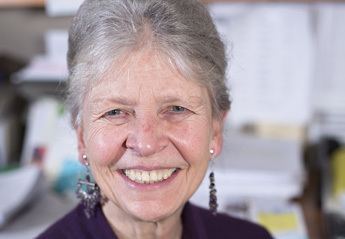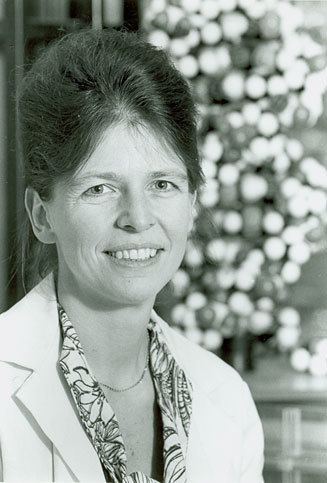Nationality American Name Joan Steitz | Doctoral students Michael Lerner Doctoral advisor James D. Watson | |
 | ||
Thesis Studies of the R17A protein (1968) Spouse Thomas A. Steitz (m. 1966) Awards Gairdner Foundation International Award Similar People Thomas A Steitz, James Watson, Suzanne Cory, Anne McLaren, Mayana Zatz | ||
Residence United States of America | ||
Joan Elaine Argetsinger Steitz (born January 26, 1941) is Sterling Professor of Molecular Biophysics and Biochemistry at Yale University and Investigator at the Howard Hughes Medical Institute. She is known for her discoveries involving RNA, including ground-breaking insights into how ribosomes interact with messenger RNA by complementary base pairing and that introns are spliced by small nuclear ribonucleic proteins (snRNPs), which occur in eukaryotes.
Contents
- Joan A Steitz Wikipedia audio article
- Early life and education
- Career
- Personal life
- Awards and honors
- References

Joan A. Steitz | Wikipedia audio article
Early life and education

Steitz was born in Minneapolis, Minnesota. She grew up in Minnesota in the 1950s and 60s at a time when there were virtually no female role models in molecular biology. She attended the then all-girls Northrop College for high school.

In 1963, Steitz received her Bachelor of Science degree in chemistry from Antioch College, Ohio, where she first became interested in molecular biology at Alex Rich's Massachusetts Institute of Technology laboratory as an Antioch "coop" intern.

After completing her undergraduate degree, Steitz applied to medical school rather than graduate school since she knew of female medical doctors but not women scientists. She was accepted to Harvard Medical School, but having been excited by a summer working as a bench scientist in the laboratory of Joseph Gall at the University of Minnesota, she declined the invitation to Harvard Medical School and instead applied to Harvard's new program in biochemistry and molecular biology. There, she was the first female graduate student to join the laboratory of Nobel Laureate James Watson, with whom she first worked on bacteriophage RNA.
Career
Steitz completed postdoctoral research at the Medical Research Council (MRC) Laboratory of Molecular Biology (LMB) at the University of Cambridge (UK), where she collaborated with Francis Crick, Sydney Brenner, and Mark Bretscher. At the LMB, Steitz focused on the question of how bacteria know where to start the "reading frame" on mRNA. In the process, Steitz discovered the exact sequences on mRNA at which bacterial ribosomes bind to produce proteins. In 1969 she published a seminal paper inNature showing the nucleotide sequence of the binding start points.
In 1970, Steitz joined the faculty at Yale. In 1975, she published the research for which she is widely known, demonstrating that ribosomes use complementary base pairing to identify the start site on mRNA.
In 1980, Steitz published another critical paper, identifying the novel entity snRNPs and their role in splicing. A snRNP is a short length of RNA, around 150 nucleotides long, that are involved in splicing introns from newly transcribed RNA (pre-mRNA) -- spliceosomes. Steitz's paper "set the field ahead by light years and heralded the avalanche of small RNAs that have since been discovered to play a role in multiple steps in RNA biosynthesis," noted Susan Berget.
Steitz later discovered another kind of snRNP particle, the snoRNP, demonstrating conclusively that introns are not "junk DNA" as they had often been described. Her work helps explain the phenomenon of "alternative RNA splicing." Part of the reason her discovery is so important is that it explains how humans are able to have only double the number of genes of a fly. "The reason we can get away with so few genes is that when you have these bits of nonsense, you can splice them out in different ways," she said. "Sometimes you can get rid of things and add things because of this splicing process so that each gene has slightly different protein products that can do slightly different things. So it multiplies up the information content in each of our genes."
Steitz's research may yield new insights into the diagnosis and treatment of autoimmune disorders such as lupus, which develop when patients make antibodies against their own DNA, snRNPs, or ribosomes.
Steitz has commented on the sexist treatment of women in science, noting that a woman scientist needs to be twice as good for half the pay. She has been a "tireless promoter of women in science," noted Christine Guthrie, who described Steitz as "one of the greatest scientists of our generation."
Steitz has served in numerous professional capacities, including as scientific director of the Jane Coffin Childs Memorial Fund for Medical Research (1991–2002) and as editorial board member of Genes & Development.
Personal life
Steitz (born Joan Argetsinger) married Thomas Steitz, also Sterling Professor of Molecular Biophysics and Biochemistry at Yale and the 2009 Nobel Prize in Chemistry laureate, in 1966. They have one son, Jon, who played baseball with the Milwaukee Brewers for three years and then entered Yale Law School in 2004, from which he graduated in 2007. Prior to entering law school, Jon earned a Bachelor of Arts in Molecular Biophysics and Biochemistry in 2002. Jon is married to Katherine Van Loon, a gastrointestinal cancer specialist at UCSF. At the time of their meeting, Van Loon was a Master of Public Health candidate at Yale University. Prior to that, Van Loon earned a Bachelor of Science in Biology from Duke University in 2000.
Awards and honors
Steitz has won numerous awards and honours including:
Her nomination for the Royal Society reads:
